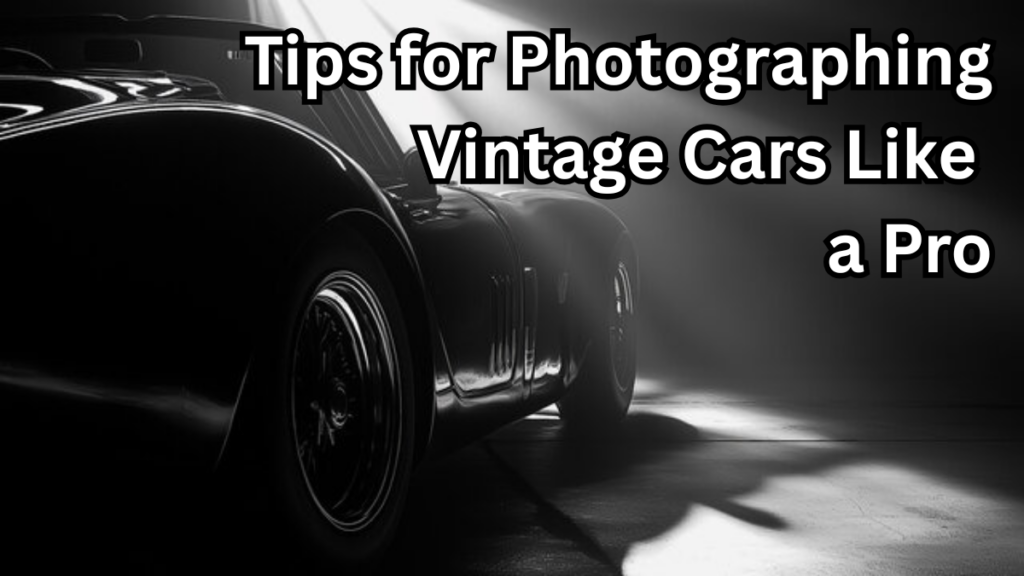There’s something timeless about vintage cars. Their curves, chrome, and character can instantly transport you to a different era. But capturing that nostalgia in a photo? That takes more than just pointing your camera and clicking.
Whether you’re a hobbyist, a social media enthusiast, or aiming for classic vehicle shoots professionally, these car photography tips will help you bring out the best in these rolling works of art.

Understand the Story Behind the Car
Vintage cars aren’t just vehicles—they’re stories on wheels. Before snapping away, get to know the car’s history.
Ask Yourself:
-
What era is the car from?
-
Was it built for speed, luxury, or practicality?
-
Are there unique design elements that define its time?
Pro Tip: Knowing the car’s background helps you choose the right setting and mood for the shoot.
Location is Everything
The setting can either elevate your photo or distract from the car’s beauty. Choose a backdrop that matches or complements the era of the car.
| Car Type | Ideal Backgrounds |
|---|---|
| 1940s Sedan | Retro diners, cobblestone streets |
| 1960s Muscle Car | Urban alleyways, empty highways |
| 1970s Convertible | Beach roads, sunlit countryside |
Pro Tip: Avoid busy or modern-looking areas unless you’re creating a contrast on purpose.
Use Natural Light to Your Advantage
Lighting makes or breaks any photo. For vintage cars, natural light brings out details like paint texture and chrome reflections.
Best Times to Shoot:
-
Golden Hour (Sunrise/Sunset): Warm tones add a nostalgic vibe
-
Overcast Days: Soft light minimizes harsh shadows
Avoid midday sun as it casts strong shadows and makes chrome parts overly reflective.
Focus on the Details
Vintage cars are full of beautiful little details—grilles, badges, gauges, and hand-stitched leather. Don’t just shoot the full car; get up close.
Detail Shots to Consider:
-
Steering wheel and dashboard
-
Hood ornaments
-
Tail lights and emblems
-
Engine bay (if open)
Bonus Tip: Use a macro lens or zoom in to isolate these features with sharp focus.
Choose Angles That Tell a Story
Angles can completely change how a car looks. Be creative and try different perspectives to find what best suits the vehicle.
| Angle | Purpose/Effect |
|---|---|
| Low Angle | Makes the car look powerful and dominant |
| Front ¾ View | Shows depth and design curves |
| Straight Side Shot | Emphasizes length and symmetry |
| Interior View | Adds personality and storytelling |
Experiment until you find the car’s best side.
Edit Thoughtfully
Post-processing helps bring out the richness of colors and textures in vintage cars without overdoing it.
Editing Tips:
-
Enhance contrast and sharpness
-
Slightly boost saturation (especially reds, greens, and yellows)
-
Add a subtle vignette for a retro feel
Pro Tip: Keep edits natural—don’t mask the vintage charm with heavy filters.
Tell a Visual Story
Think beyond single photos. Create a narrative through a series:
-
Wide shot of the full car
-
Close-up of the logo
-
Interior details
-
The owner (if possible) with the car
Every vintage car has a story—make your photos tell it.
Quick-Glance Checklist for Classic Vehicle Shoots
| Tip | Why It Matters |
|---|---|
| Know the Car’s History | Sets tone and theme |
| Pick the Right Location | Enhances authenticity |
| Use Natural Light | Shows detail and depth |
| Highlight Unique Features | Adds visual interest |
| Play with Angles | Offers variety and perspective |
| Edit Carefully | Enhances without overpowering |
| Create a Story Sequence | Engages the viewer emotionally |
FAQs:
Q1: What’s the best camera setting for vintage car photography?
A: Use aperture priority mode (f/5.6–f/8) for sharpness, and keep ISO low (100–400) to reduce grain. Always shoot in RAW for editing flexibility.
Q2: Should I use a tripod for classic vehicle shoots?
A: Yes, especially for low-light or detailed close-up shots. A tripod ensures stability and sharpness.
Q3: How do I avoid reflections on shiny surfaces like chrome?
A: Use a polarizing filter and shoot at angles that reduce glare. Overcast lighting helps too.
Q4: Can smartphone cameras work for vintage car photography?
A: Absolutely. Modern smartphones have excellent cameras. Just pay extra attention to lighting, composition, and editing.
Final Thoughts
Photographing vintage cars isn’t just about documenting a machine—it’s about capturing a feeling. With the right car photography tips and a bit of creativity, your shots can turn into timeless pieces of art.
Click here to learn more
Sachin is a dedicated writer specializing in education, career, and recruitment topics, delivering clear and actionable insights to empower readers.
